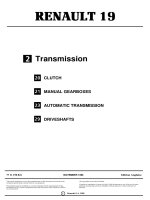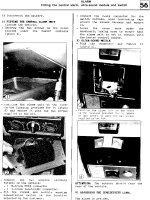Tài liệu QUEUEING THEORY WITH APPLICATIONS TO PACKET TELECOMMUNICATION pptx
Bạn đang xem bản rút gọn của tài liệu. Xem và tải ngay bản đầy đủ của tài liệu tại đây (6.97 MB, 342 trang )
TeAM YYePG
Digitally signed by TeAM YYePG
DN: cn=TeAM YYePG, c=US, o=TeAM YYePG,
ou=TeAM YYePG, email=
Reason: I attest to the accuracy and integrity of
this document
Date: 2005.05.26 21:14:08 +08'00'
QUEUEING THEORY WITH
APPLICATIONS TO PACKET
TELECOMMUNICATION
This page intentionally left blank
QUEUEING THEORY WITH
APPLICATIONS TO PACKET
TELECOMMUNICATION
JOHN N. DAIGLE
Prof. of Electrical Engineering
The University of Mississippi
University, MS 38677
Springer
eBook ISBN: 0-387-22859-4
Print ISBN: 0-387-22857-8
Print ©2005 Springer Science + Business Media, Inc.
All rights reserved
No part of this eBook may be reproduced or transmitted in any form or by any means, electronic,
mechanical, recording, or otherwise, without written consent from the Publisher
Created in the United States of America
Boston
©2005 Springer Science + Business Media, Inc.
Visit Springer's eBookstore at:
and the Springer Global Website Online at:
NOTE TO INSTRUCTORS
A complete solution manual has been prepared for use by those interested in
using this book as the primary text in a course or for independent study. Inter-
ested persons should please contact the publisher or the author at
/>~
wcdaigle/QueueingText to obtain an electronic copy
of the solution manual as well as other support materials, such as computer
programs that implement many of the computational procedures described in
this book.
This page intentionally left blank
Contents
List of Figures
List of Tables
Preface
Acknowledgments
xi
xv
xvii
xxiii
1.
TERMINOLOGY AND EXAMPLES
1.1
1.2
The Terminology of Queueing Systems
Examples of Application to System Design
1.2.1
1.2.2
1.2.3
Cellular Telephony
Multiplexing Packets
CDMA-Based Cellular Data
1.3
Summary
2.
REVIEW OF RANDOM PROCESSES
2.1
Statistical Experiments and Probability
2.1.1
2.1.2
Statistical Experiments
Conditioning Experiments
2.2
2.3
2.4
2.5
Random Variables
Exponential Distribution
Poisson Process
Markov Chains
3.
ELEMENTARY CTMC-BASED QUEUEING MODELS
3.1
M/M/1 Queueing System
3.1.1
3.1.2
3.1.3
Time-Dependent M/M/1 Occupancy Distribution
Stochastic Equilibrium M/M/1 Distributions
Busy Period for M/M/1 Queueing System
1
2
9
9
11
14
17
19
20
20
22
27
33
39
45
57
58
58
60
76
viii
QUEUEING THEORY FOR TELECOMMUNICATIONS
3.2
3.3
Dynamical Equations for General Birth-Death Process
Time-Dependent Probabilities for Finite-State Systems
3.3.1
3.3.2
Classical Approach
Jensen’s Method
3.4
3.5
3.6
Balance Equations Approach for Systems in Equilibrium
Probability Generating Function Approach
Supplementary Problems
4.
ADVANCED CTMC-BASED QUEUEING MODELS
4.1
Networks
4.1.1
4.1.2
4.1.3
Feedforward Networks: Fixed Routing
Arbitrary Open Networks
Closed Networks of Single Servers
4.2
Phase-Dependent Arrivals and Service
4.2.1
4.2.2
4.2.3
4.2.4
Probability Generating Function Approach
Matrix Geometric Method
Rate Matrix Computation via Eigenanalysis
Generalized State-Space Methods
4.3
4.4
Phase-Type Distributions
Supplementary Problems
5.
THE BASIC M/G/1 QUEUEING SYSTEM
5.1
M/G/1 Transform Equations
5.1.1
5.1.2
5.1.3
Sojourn Time for M/G/1
Waiting Time for M/G/1
Busy Period for M/G/1
5.2
Ergodic Occupancy Distribution for M/G/1
5.2.1
5.2.2
5.2.3
Discrete Fourier Transform Approach
Recursive Approach
Generalized State-Space Approach
5.3
Expected Values Via Renewal Theory
5.3.1
5.3.2
Expected Waiting and Renewal Theory
Busy Periods and Alternating Renewal Theory
5.4
Supplementary Problems
6.
THE M/G/1 QUEUEING SYSTEM WITH PRIORITY
6.1
6.2
6.3
M/G/1 Under LCFS-PR Discipline
M/G/1 System Exceptional First Service
M/G/1 under HOL Priority
81
83
84
88
91
98
101
107
108
109
110
111
122
124
138
143
146
152
156
159
161
165
167
167
170
170
180
183
210
210
216
219
225
226
229
236
Contents
ix
6.3.1
6.3.2
Higher Priority Customers
Lower Priority Customers
6.4
6.5
Ergodic Occupancy Probabilities for Priority Queues
Expected Waiting Times under HOL Priority
6.5.1
6.5.2
HOL Discipline
HOL-PR Discipline
7.
VECTOR MARKOV CHAINS ANALYSIS
7.1
7.2
7.3
7.4
7.5
7.6
7.7
The M/G/1 and G/M/1 Paradigms
G/M/1 Solution Methodology
M/G/1 Solution Methodology
Application to Statistical Multiplexing
Generalized State Space Approach: Complex Boundaries
Summary
Supplementary Problems
8.
CLOSING REMARKS
References
Index
About the Author
238
241
244
246
248
249
253
254
259
261
265
278
290
294
297
301
309
315
This page intentionally left blank
List of Figures
1.1
1.2
1.3
1.4
1.5
1.6
1.7
1.8
2.1
3.1
3.2
3.3
3.4
3.5
Schematic diagram of a single-server queueing system.
Sequence of events for first customer.
Sequence of events for general customer.
Typical realization for unfinished work.
Blocking probability as a function of population size at
a load of
Queue length survivor function for an N-to-1 multi-
plexing system at a traffic intensity of 0.9 with N as a
parameter and with independent, identically distributed
arrivals.
Queue length survivor function for an 8-to-1 multiplex-
ing system at a traffic intensity of 0.9 with average run
length as a parameter.
Comparison between a system serving a fixed number
of 16 units per frame and a system serving a binomial
number of units with an average of 16 at a traffic inten-
sity of 0.9.
Distribution function for the random variable defined
in Example 2.4.
Survivor function for system occupancy for several val-
ues of
Schematic diagram of a single-server queueing system.
Schematic diagram of a simple network of queues.
Sequence of busy and idle periods.
Sequence of service times during a generic busy period.
2
3
4
6
11
14
15
16
29
63
65
76
76
77
xii
QUEUEING THEORY FOR TELECOMMUNICATIONS
3.6
3.7
3.8
3.9
3.10
3.11
3.12
4.1
4.2
4.3
5.1
5.2
5.3
5.4
5.5
5.6
5.7
5.8
Busy period decompositions depending upon interar-
rival versus service times.
Time-dependent state probabilities corresponding to Ex-
ample 3.1.
Steps involved in randomization.
State diagram for M/M/1 System.
State diagram for general birth-death process.
State diagram for general birth-death process.
State diagram illustrating local balance.
Block diagram for window flow control network.
State diagram for phase process.
State diagram for system having phase-dependent ar-
rival and service rates.
Survivor functions with deterministic, Erlang-2, expo-
nential, branching Erlang and gamma service-time dis-
tributions at
Survivor functions for system occupancy with message
lengths drawn from truncated geometric distributions
at
Survivor functions for system having exponential ordi-
nary and exceptional first service
and as a parameter.
Survivor functions with unit deterministic service and
binomially distributed arrivals with N as a parameter
at
Survivor functions with unit-mean Erlang-10 service
and Poisson arrivals with C as a parameter at a traffic
load of 0.9.
Survivor functions with unit-mean Erlang-K service
and Poisson arrivals with K as a parameter at a traf-
fic load of 0.9.
Survivorfunctions with and Pade(2, 2) ser-
vice, Poisson arrivals, and a traffic load of 0.9.
Survivor functions for deterministic (16) batch sizes
with Pade deterministic service and
Poisson arrivals at a traffic load of 0.9 for various choices
of
79
86
90
92
92
95
98
117
122
123
176
178
198
199
201
203
205
206
List of Figures
xiii
5.9
5.10
5.11
5.12
6.1
7.1
7.2
7.3
7.4
Survivor functions for deterministic (16) batch sizes
with Erlang-K-approximated deterministic service and
Poisson arrivals at a traffic load of 0.9 for various choices
of
K.
Survivor functions for binomial (64,0.25) and deter-
ministic (16) batch sizes with deterministic service ap-
proximated by a Pade(32, 32) approximation and Pois-
son arrivals at a traffic load of 0.9.
A sample of service times.
An observed interval of a renewal process.
HOL service discipline.
Survivor functions for occupancy distributions for sta-
tistical multiplexing system with 0.5 to 1.0 speed con-
version at
Survivor functions for occupancy distributions for sta-
tistical multiplexing system with equal line and trunk
capacities at
Survivor functions for occupancy distributions for sta-
tistical multiplexing system with and without line-speed
conversion at
Survivor functions for occupancy distributions for wire-
less communication link with on time as a parameter.
207
208
211
212
237
273
277
278
291
This page intentionally left blank
List of Tables
5.1
5.2
5.3
5.4
5.5
5.6
5.7
5.8
7.1
7.2
7.3
7.4
7.5
7.6
Blocking probabilities versus occupancy probabilities
for various service time distributions.
Parameters for Example 5.5.
Formulae to compute parameter values for Example 5.6.
Parameter values for Example 5.8.
Occupancy values as a function of the number of units
served for the system of Example 5.8.
Comparison of values of survivor function computed
using various Pade approximations for service time in
Example 5.10.
Possible data structure for representing the input pa-
rameters in a program to implement the scalar case of
the generalized state space approach.
Possible data structure for representing the output pa-
rameters in a program to implement the scalar case of
the generalized state space approach.
Definition of the phases for the problem solved in Ex-
ample 7.1.
Definition of the phases for the system of Exercise 7.8.
Mean and second moments of queue lengths for multi-
plexed lines with line speed conversion.
Mean and second moments of queue lengths for multi-
plexed lines with no line speed conversion.
Transition probabilities for the system of Example 7.4.
Major characteristics of the solution process for the
system of Example 7.4.
180
193
197
200
202
204
209
209
269
269
274
277
289
290
This page intentionally left blank
Preface
Soon after Samuel Morse’s telegraphing device led to a deployed electri-
cal telecommunications system in 1843, waiting lines began to form by those
wanting to use the system. At this writing queueing is still a significant factor in
designing and operating communications services, whether they are provided
over the Internet or by other means, such as circuit switched networks.
This book is intended to provide an efficient introduction to the fundamental
concepts and principles underlying the study of queueing systems as they ap-
ply to telecommunications networks and systems. Our objective is to provide
sufficient background to allow our readers to formulate and solve interesting
queueing problems in the telecommunications area. The book contains a se-
lection of material that provides the reader with a sufficient background to read
much of the queueing theory-based literature on telecommunications and net-
working, understand their modeling assumptions and solution procedures, and
assess the quality of their results.
This text is a revision and expansion of an earlier text. It has been used
as a primary text for graduate courses in queueing theory in both Electrical
Engineering and Operations Research departments. There is more than enough
material for a one-semester course, and it can easily be used as the primary text
for a two-semester course if supplemented by a small number of current journal
articles.
Our goals are directed towards the development of an intuitive understand-
ing of how queueing systems work and building the mathematical tools needed
to formulate and solve problems in the most elementary setting possible. Nu-
merous examples are included and exercises are provided with these goals in
mind. These exercises are placed within the text so that they can be discussed
at the appropriate time.
The instructor can easily vary the pace of the course according to the char-
acteristics of individual classes. For example, the instructor can increase the
pace by assigning virtually every exercise as homework, testing often, and cov-
xviii
QUEUEING THEORY FOR TELECOMMUNICATIONS
ering topics from the literature in detail. The pace can be decreased to virtually
any desired level by discussing the solutions to the exercises during the lecture
periods. I have worked mostly with graduate students and have found that we
achieve more in a course when the students work exercises on the blackboard
during the lecture period. This tends to generate discussions that draw the
students in and bring the material to life.
The minimum prerequisite for this course is an understanding of calculus
and linear algebra. However, we have achieved much better results when the
students have had at least an introductory course in probability. The best re-
sults have been obtained when the students have had a traditional electrical
engineering background, including transform theory, an introductory course in
stochastic processes, and a course in computer communications.
We now present an abbreviated summary of the technical content of this
book. In Chapter 1, we introduce some general terminology from queueing
systems and some elementary concepts and terminology from the general the-
ory of stochastic processes, which will be useful in our study of queueing
systems. The waiting time process for a single-server, first-come-first-serve
(FCFS) queueing system, is discussed. We also demonstrate the application
of queueing analysis to the design of wireless communication systems and IP
switches. In the process, we demonstrate the importance of choosing queue-
ing models that are sufficiently rich to capture the important properties of the
problem under study.
In Chapter 2, we review some of the key results from the theory of ran-
dom processes that are needed in the study of queueing systems. In the first
section, we provide a brief review of probability. We begin with a definition
of the elements of a statistical experiment and conclude with a discussion of
computing event probabilities via conditioning. We then discuss random vari-
ables, their distributions, and manipulation of distributions. In the third and
fourth sections, we develop some of the key properties of the exponential dis-
tribution and the Poisson process. In the fifth section, we review discrete-
and continuous-parameter Markov chains defined on the nonnegative integers.
Our goal is to review and reinforce a subset of the ideas and principles from
the theory of stochastic processes that is needed for understanding queueing
systems. As an example, we review in detail the relationship between discrete-
time and discrete-parameter stochastic processes, which is very important to
the understanding of queueing theory but often ignored in courses on stochastic
processes. Similarly, the relationship between frequency-averaged and time-
averaged probabilities is addressed in detail in Chapter 2.
In Chapter 3, we explore the analysis of several queueing models that are
characterized as discrete-valued, continuous-time Markov chains (CTMCs).
That is, the queueing systems examined Chapter 3 have a countable state
space, and the dwell times in each state are drawn from exponential distri-
PREFACE
xix
butions whose parameters are possibly state-dependent. We begin by examin-
ing the well known M/M/1 queueing system, which has Poisson arrivals and
identically distributed exponential service times. For this model, we consider
both the time-dependent and equilibrium occupancy distributions, the stochas-
tic equilibrium sojourn and waiting time distributions, and the stochastic equi-
librium distribution of the length of the busy period. Several related processes,
including the departure process, are introduced, and these are used to obtain
equilibrium occupancy distributions for simple networks of queues.
After discussing the M/M/1 system, we consider the time-dependent behav-
ior of finite-state general birth-death models. A reasonably complete derivation
based upon classical methods is presented, and the rate of convergence of the
system to stochastic equilibrium is discussed. Additionally, the process of ran-
domization, or equivalently uniformization, is introduced. Randomization is
described in general terms, and an example that illustrates its application is
provided. We also discuss the balance equation approach to formulating equi-
librium state probability equations for birth-death processes and other more
general processes. Elementary traffic engineering models are introduced and
blocking probabilities for these systems are discussed. Finally, we introduce
the probability generating function technique for solving balance equations.
In Chapter 4, we continue our analysis of queueing models that are charac-
terized by CTMCs. We discuss simple networks of exponential service stations
of the feedforward, open, and closed varieties. We discuss the form of the joint
state probability mass functions for such systems, which are of the so-called
product form type. We discuss in detail a novel technique, due to Gordon
[1990], for obtaining the normalizing constant for simple closed queueing net-
works in closed form. This technique makes use of generating functions and
contour integration, which are so familiar to many engineers.
Next, we address the solution of a two-dimensional queueing model in
which both the arrival and service rates are determined by the state of a single
independent CTMC. This type of two-dimensional Markov chain is called a
quasi-birth and death process (QBD), which is a vector version of the scalar
birth-death process discussed previously. A number of techniques for solving
such problems are developed. The first approach discussed uses the probabil-
ity generating function approach. We make extensive use of eigenvector-based
analysis to resolve unknown probabilities. Next, the matrix analytic technique
is introduced and used to solve for the state probabilities. A technique based
on solving eigensystems for finding the rate matrix of the matrix geometric
method, which reveals the entire solution, is discussed next. Finally, a gen-
eralized state space approach, which seems to have been introduced first by
Akar et. al [1998], is developed. We show how this technique can be used
efficiently to obtain the rate matrix, thereby complementing the matrix ana-
lytic approach. We then introduce distributions of the phase (PH) type, and
xx
QUEUEING THEORY FOR TELECOMMUNICATIONS
we provide the equilibrium occupancy distribution for the M/PH/1 system in
matrix geometric form. We conclude the chapter with a set of supplementary
exercises.
In Chapter 5, we introduce the M/G/1 queueing system. We begin with a
classical development of the Pollaczek-Khintchine transform equation for the
occupancy distribution. We also develop the Laplace-Stieltjes transforms for
the ergodic waiting time, sojourn time, and busy period distributions.
We next address inversion of probability generating functions. Three meth-
ods are discussed. The first method is based upon Fourier analysis, the second
approach is recursive, and the third approach is based on generalized state
space methods, which were used earlier to determine the equilibrium probabil-
ities for QBD processes. A number of practical issues regarding a variety of
approximations are addressed using the generalized state space approach. For
example, in the case of systems having deterministic service time, we obtain
queue length distributions subject to batch arrivals for the cases where batch
sizes are binomially distributed. We explore convergence of the queue length
distribution to that of the M/D/1 system. We also explore the usefulness of the
Pade approximation to deterministic service in a variety of contexts.
We next turn our attention to the direct computation of average waiting and
sojourn times for the M/G/1 queueing system. Our development follows that
for the M/M/1 system to the point at which the consequences of not having the
Markovian property surfaces. At this point, a little renewal theory is introduced
so that the analysis can be completed. Additional insight into the properties of
the M/G/1 system are also introduced at this point. Following completion of
the waiting- and sojourn-time development, we introduce alternating renewal
theory and use a basic result of alternating renewal theory to compute the av-
erage length of the M/G/1 busy period directly. The results of this section play
a key role in the analysis of queueing systems with priority, which we address
in Chapter 6.
We begin Chapter 6 with an analysis of the M/G/1 system having the last
come first serve service discipline. We show that the Pollaczek-Khintchine
transform equations for the waiting and sojourn times can be expressed as ge-
ometrically weighted sums of random variables. Next, we analyze the M/G/1
queueing system with exceptional first service. We begin our development by
deriving the Pollaczek-Khintchine transform equation of the occupancy distri-
bution using the same argument by which Fuhrmann-Cooper decomposition
was derived. This approach avoids the difficulties of writing and solving dif-
ference equations. We then use decomposition techniques liberally in the re-
mainder of the chapter to study the M/G/1 queueing system with externally
assigned priorities and head-of-the-line service. Transform equations are de-
veloped for the occupancy, waiting-time and sojourn-time distributions. Inver-
sion of transform equations to obtain occupancy distribution is then discussed.
PREFACE
xxi
Finally, we develop expressions for the average waiting and sojourn times for
the M/G/1 queueing system underboth preemptive and nonpreemptive priority
disciplines.
In Chapter 7 we introduce the G/M/1 and M/G/1 paradigms, which have
been found to be useful in solving practical problems and have been discussed
at length in Neuts’ books. These paradigms are natural extensions of the or-
dinary M/G/1 and G/M/1 systems. In particular, the structure of the one-step
transition probability matrices for the embedded Markov chains for these sys-
tems are simply matrix versions of the one-step transition probability matrices
for the embedded Markov chains of the elementary systems.
In the initial part of the chapter, Markov chains of the M/G/1 and G/M/1
type are defined. The general solution procedure for models of the G/M/1
type and the M/G/1 with simple boundaries are discussed. The application
of M/G/1 paradigm ideas to analysis of statistical multiplexing systems is then
discussed by way of examples. Then, we extend our earlier development of the
generalized state space methods to the case of the Markov chains of the M/G/1
type with complex boundary conditions. The methodology presented there is
relatively new, and we believe our presentation is novel. Because generalized
state-space procedures are relatively new, we attempt to provide a thorough
introduction and reinforce the concepts through an example. Finally, additional
environments where Markov chains of the G/M1 and M/G/1 types surface are
discussed and pointers to descriptions of a variety of techniques are given.
We close in Chapter 8 with a brief discussion of a number of nontraditional
techniques for gaining insights into the behavior of queueing systems. Among
these are asymptotic methods and the statistical envelope approach introduced
by Boorstyn and others.
JOHN N. DAIGLE
This page intentionally left blank
Acknowledgments
For their many valuable contributions, I am indebted to many people. John
Mahoney of Bell Laboratories guided my early study of communications. Shel-
don Ross of the University of California-Berkeley introduced me to the queue-
ing theory and taught me how to think about queueing problems. Tom Robbins
of Addison Wesley, Jim Meditch of The University of Washington, Ray Pick-
holtz of The George Washington University, and Bill Tranter of the Virginia
Polytechnic Institute and State University initially encouraged me to write this
book. Marty Wortman of Texas A&M University taught from early drafts
and provided encouragement and criticism for several years. John Spragins
of Clemson University and Dave Tipper of The University of Pittsburgh taught
from the various draft forms and offered many suggestions for improvement.
Discussions with Ralph Disney of Texas A&M University, Bob Cooper of
Florida Atlantic University, Jim Meditch, and Paul Schweitzer of the Univer-
sity of Rochester also yielded many improvements in technical content.
Numerous students, most notably Nikhil Jain, John Kobza, Joe Langford,
Marcos Magalhães, Naresh Rao, Stan Tang, and Steve Whitehead have asked
insightful questions that have resulted in many of the exercises. Mary Jo
Zukoski played a key role in developing the solution manual for the first edi-
tion.
Nail Akar of Bilikent University contributed much to my education on the
generalized state space approach, and provided invaluable help
in setting up and debugging a suitable programming environment for LAPACK
routines. Ongoing discussions with Martin Reisslein, David Lucantoni, Ness
Shroff, and Jorg Liebeherr have helped to keep me up-to-date on emerging
developments. Alex Greene and Mellissa Sullivan of Kluwer Publishers have
provided the appropriate encouragement to bring the manuscript to completion.
Finally, I am indebted to Katherine Daigle who read numerous drafts and
provided many valuable suggestions to improve organization and clarity. For
all errors and flaws in the presentation, I owe thanks only to myself.









